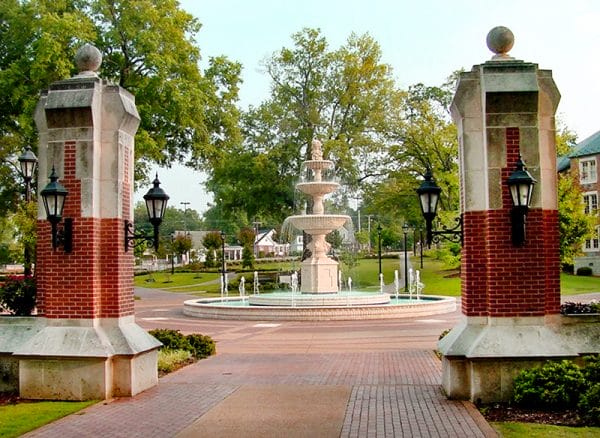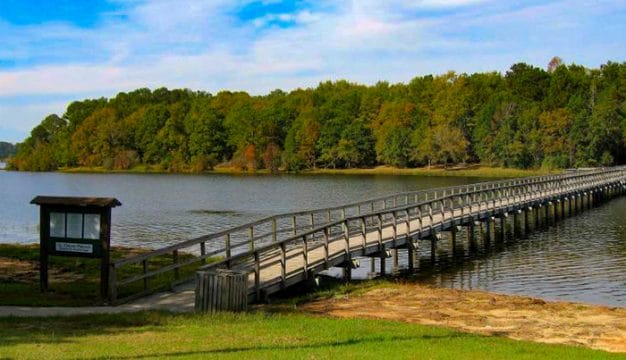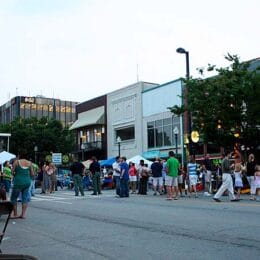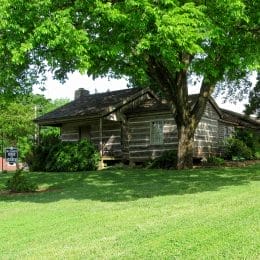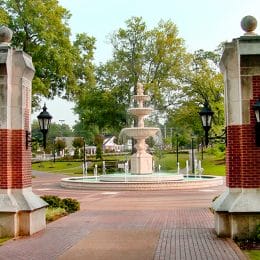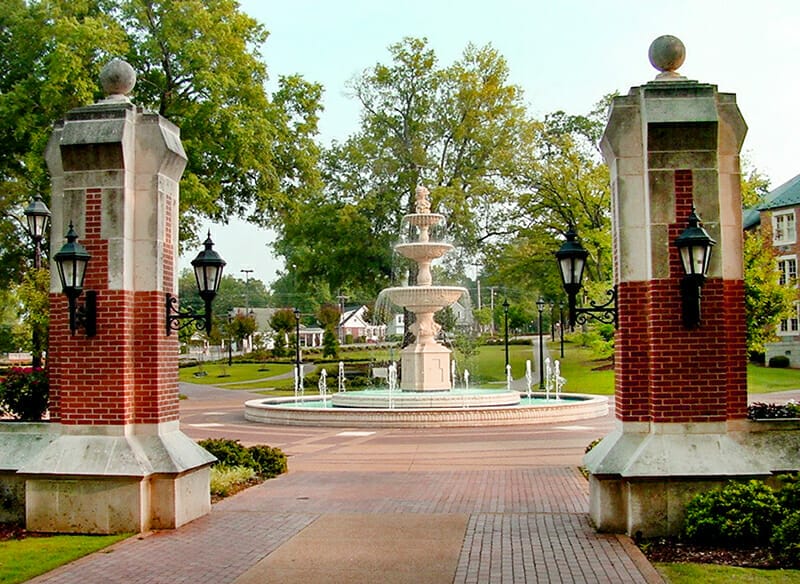Florence
Florence is located in north Alabama along the Tennessee River and is the county seat of Lauderdale County. The town was named after Florence, in Tuscany, Italy, by Italian engineer Ferdinand Sannoner, who surveyed the land for the settlement. Currently, Florence is known as “Alabama’s Renaissance City” because of its annual hosting of the Alabama Renaissance Faire. Florence has a city council form of government with a mayor and six council members who each serve a four-year term. It is located in an area of the state known as “The Shoals” and is the largest city in that region. James Thomas Rapier, who was among the first group of African Americans from Alabama elected to the U.S. Congress during Reconstruction, was born in Florence, as was civil rights activist and politician Oscar DePriest. Noted music industry figures Donnie Fritts and Sam Phillips were born in the city as well.
History
The area of present-day Lauderdale County and Florence was originally part of the Chickasaw Nation, which ceded its lands to the federal government in several treaties during the early nineteenth century. Shortly after the last Chickasaw treaty was signed, the federal government held the first land sale in the area. The Cypress Land Company purchased the land that Florence now occupies, anticipating that it would become a major commercial town because of its location on a hill overlooking the Tennessee River. Gen. John Coffee, a partner in the Cypress Land Company with future U.S. president Andrew Jackson, commissioned Italian engineer Ferdinand Sannoner to survey the land in 1818. Coffee was so pleased with Sannoner’s work that he asked the surveyor to name the town; he chose Florence, his home in Italy. The city of Florence was established on March 12, 1818, and immediately took its place as the county seat, but it was not incorporated officially until nearly a decade later in 1826. Although the city did become an industrial, agricultural, and commercial center, it did not flourish to the extent the founders in the Cypress Land Company had anticipated.
 Memphis & Charleston Railroad, ca. 1890
The first land sale to the public was held in July 1818, with another sale in 1823; records show that 180 people, including Andrew Jackson, acquired lots after the two sales. The city’s elevated location attracted people because they believed it allow them to avoid diseases that occurred in lower elevations along the river. Before long, Florence had become one of the first textile centers in the Southeast. The Civil War caused a severe economic downturn in the town, as it repeatedly changed hands between Union and Confederate forces, leaving nearly all of its industrial base and parts of the city destroyed.
Memphis & Charleston Railroad, ca. 1890
The first land sale to the public was held in July 1818, with another sale in 1823; records show that 180 people, including Andrew Jackson, acquired lots after the two sales. The city’s elevated location attracted people because they believed it allow them to avoid diseases that occurred in lower elevations along the river. Before long, Florence had become one of the first textile centers in the Southeast. The Civil War caused a severe economic downturn in the town, as it repeatedly changed hands between Union and Confederate forces, leaving nearly all of its industrial base and parts of the city destroyed.
In 1885, LaGrange College (now the University of North Alabama), moved from nearby Leighton, Colbert County, to Florence and played an important role in spurring the city’s economic revival. By 1887, the town had begun to flourish once again, with the population increasing from 1,600 in 1865 to some 6,000. In 1889, the Florence Wagon Company began operation and became the second-largest such company in the South.
Economic Development
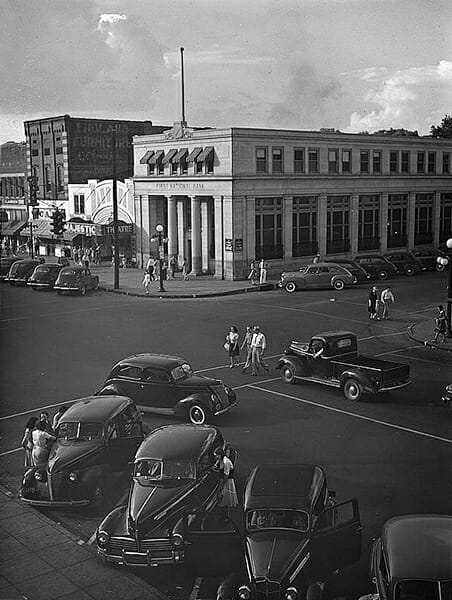 Florence, 1942
Along with the early development of industry and the opening of the University of North Alabama (UNA) in 1885, the docking and shipping business in Florence has played a major role in the city’s economic history. Florence’s port, known originally as North Port, was at one time the northernmost port along the Tennessee River because of then-impassable shoals further north. The port enabled the town to flourish and evolve into a commercial center, shipping imported goods upriver from New Orleans and other areas. Supply wagons would then transfer these goods from the port to surrounding towns. The Port of Florence today still plays a significant role in connecting northwest Alabama and southern Tennessee to other major ports in the South. The Tennessee Southern Railroad maintains a partnership with the Port of Florence, providing access to the port, as well as conducting barge, rail, and truck operations.
Florence, 1942
Along with the early development of industry and the opening of the University of North Alabama (UNA) in 1885, the docking and shipping business in Florence has played a major role in the city’s economic history. Florence’s port, known originally as North Port, was at one time the northernmost port along the Tennessee River because of then-impassable shoals further north. The port enabled the town to flourish and evolve into a commercial center, shipping imported goods upriver from New Orleans and other areas. Supply wagons would then transfer these goods from the port to surrounding towns. The Port of Florence today still plays a significant role in connecting northwest Alabama and southern Tennessee to other major ports in the South. The Tennessee Southern Railroad maintains a partnership with the Port of Florence, providing access to the port, as well as conducting barge, rail, and truck operations.
Florence also lies at the center of the “Growth Triangle” formed by Memphis, Nashville, and Birmingham. This region achieved its name by being one of the fastest growing areas in the country, supporting 270 manufacturing and distribution operations in the Florence-Muscle Shoals area alone. One manufacturing company, Wise Alloys, was founded in the Shoals in 1941 to manufacture aluminum for airplanes in World War II. This company is still one of the top employers of Florence citizens, currently listed as the third leading U.S. producer of aluminum cans for the beverage and food industries.
Demographics
According to 2020 Census estimates, Florence recorded a population of 40,652. Of that number, 75.5 percent identified themselves as white, 19.0 percent as African American, 4.2 percent as Hispanic, 3.1 percent as two or more races, 1.0 percent as Asian, 0.7 percent as American Indian, and 0.2 as Native Hawaiian and Other Pacific Islander. The city’s median household income was $39,735, and per capita income was $25,424 .
Employment
According to 2020 Census estimates, the workforce in Florence was divided among the following industrial categories:
- Educational services, and health care and social assistance (23.4 percent)
- Retail trade (17.9 percent)
- Arts, entertainment, recreation, and accommodation and food services (14.5 percent)
- Manufacturing (13.7 percent)
- Professional, scientific, management, and administrative and waste management services (7.8 percent)
- Construction (4.5 percent)
- Other services, except public administration (3.8 percent)
- Finance, insurance, and real estate, rental, and leasing (3.6 percent)
- Public administration (3.5 percent)
- Information (2.6 percent)
- Transportation and warehousing and utilities (2.4 percent)
- Wholesale trade (2.2 percent)
- Agriculture, forestry, fishing and hunting, and extractive (0.1 percent)
Education
The Florence Public School System has three elementary schools, two middle schools, two high schools, and five private schools. Florence also has the Florence Freshman Center, which is for ninth grade only, as well as the Florence Learning Center, which includes middle school and high school grade levels. UNA is the oldest four-year public university in the state.
Transportation
Highway 72 and Highway 43 both offer connections to Florence. Many visitors travelling from Birmingham, Huntsville, cities in the neighboring state of Tennessee, and even Atlanta, Georgia, take advantage of these two routes. Alabama 157 is another important highway that acts as a four-lane link to Interstate 65 approximately 45 minutes outside of Florence. In 2007, the completed highway became known as the University of North Alabama Highway. Florence has one airfield, the Northwest Alabama Regional Airport, which is a small airport in the Shoals, that provides facilities for general aviation. Local industries continue to use the Tennessee Southern Railroad from Florence to Columbia, Tennessee, as well as the Port of Florence on Pickwick Lake along the Tennessee River.
Events and Places of Interest
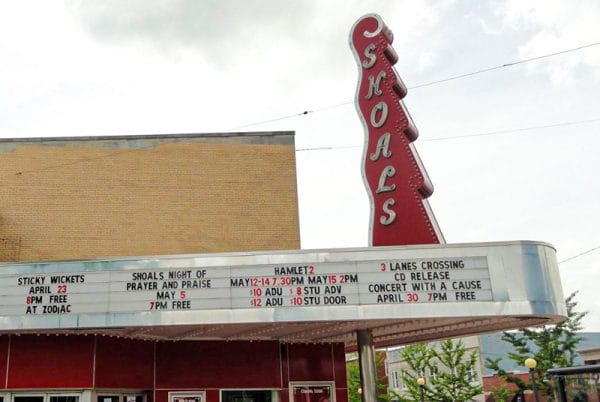 Shoals Theatre in Florence
There are many events and places to visit in Florence. The Indian Mound and Museum interprets the Tennessee Valley’s largest domiciliary mound, a human-made mountain of dirt and natural debris that served as the base for homes during the Woodland period of Native American prehistory. Also commemorating the Native American history of the region is the annual Trail of Tears Motorcycle Ride, held every third Saturday in September. Other events include the Frontier Days Celebration and the Freedom of America Celebration held on July 4 each year.
Shoals Theatre in Florence
There are many events and places to visit in Florence. The Indian Mound and Museum interprets the Tennessee Valley’s largest domiciliary mound, a human-made mountain of dirt and natural debris that served as the base for homes during the Woodland period of Native American prehistory. Also commemorating the Native American history of the region is the annual Trail of Tears Motorcycle Ride, held every third Saturday in September. Other events include the Frontier Days Celebration and the Freedom of America Celebration held on July 4 each year.
The Alabama Renaissance Faire takes place in Florence every October; it has been named one of the top 20 events in the Southeast by the Southeast Tourism Society. Arts Alive is a juried gallery exhibition held every May at the Kennedy-Douglass Center for the Arts and includes artist booths in adjoining Wilson Park. The Children’s Museum of the Shoals offers hands-on activities for children that are geared toward enriching courses of study in local schools.
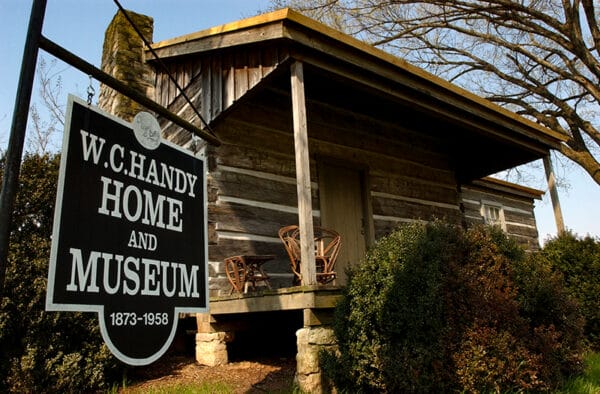 W. C. Handy Home and Museum
One notable site to visit in Florence is the Rosenbaum House, the only house in the state of Alabama designed by famed architect Frank Lloyd Wright. Pope’s Tavern Museum is one of the oldest structures in Florence and served as a hospital for Confederate and Union soldiers during the Civil War. Another significant destination is the W. C. Handy Home, Museum, and Library, celebrating the life and work of the Father of the Blues. The town also holds a week-long W. C. Handy Music Festival during the summer.
W. C. Handy Home and Museum
One notable site to visit in Florence is the Rosenbaum House, the only house in the state of Alabama designed by famed architect Frank Lloyd Wright. Pope’s Tavern Museum is one of the oldest structures in Florence and served as a hospital for Confederate and Union soldiers during the Civil War. Another significant destination is the W. C. Handy Home, Museum, and Library, celebrating the life and work of the Father of the Blues. The town also holds a week-long W. C. Handy Music Festival during the summer.
The Cherry Street Historic District in Florence includes 52 structures built around the turn of the twentieth century. The entire district is listed on the National Register of Historic Places. Also on the National Register and the Alabama Register of Landmarks and Heritage is the Old Florence Water Tower, built by the Jeter and Boardman Gas Association in 1889. Florence is also home to 10 public parks and two public lakes that provide numerous outdoor recreation opportunities. Wilson Lock and Dam was completed in the early 1920s to make a portion of the Tennessee River navigable and has become a major transportation resource for the Shoals Area and a foundation for the Tennessee Valley Authority, as well as a popular recreational area.
Further Reading
- Barske, Carolyn. Florence. Images of America Series. Charleston, S.C.: Arcadia Publishing, 2014.
- The Heritage of Lauderdale County. Clanton, Ala.: Heritage Publishing Consultants, 1999.
- McDonald, William Lindsey. A Walk Through the Past. Killen, Ala.: Heart of Dixie Publications, 2003.
External Links
- City of Florence
- Port of Florence
- Lauderdale County
- Frank Lloyd Wright Rosenbaum House
- The Shoals Theatre
- University of North Alabama
- Florence City Schools
- Florence-Lauderdale Public Library
- W.C. Handy Music Festival
- Alabama Renaissance Faire
- TimesDaily
- Shoals Chamber of Commerce
- Alabama Mountain Lakes Tourist Association
- Encycylopedia of Southern Jewish Communities
